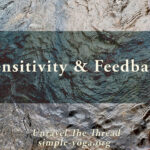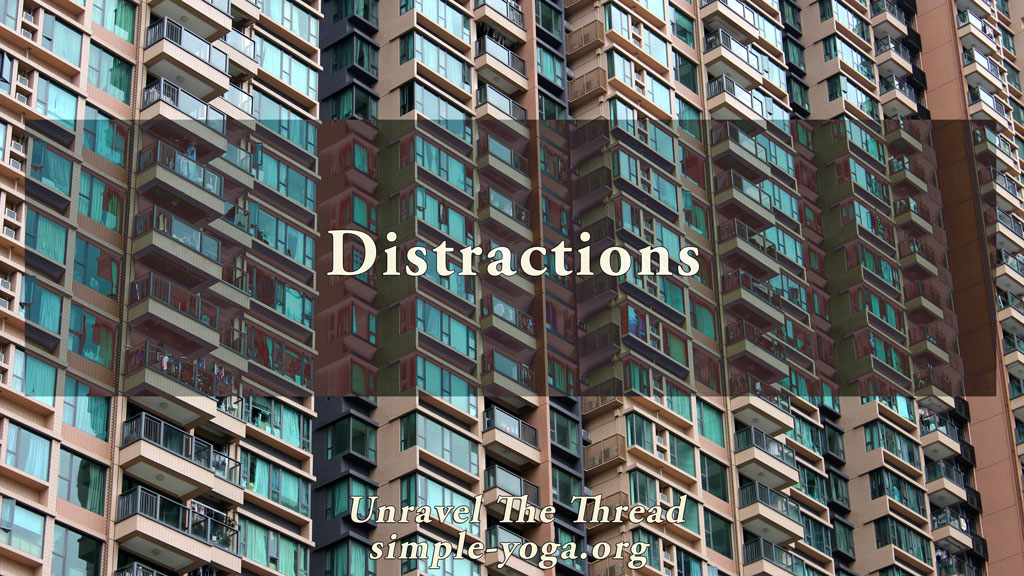
Range of Awareness – Open awareness
April 8, 2024
Sensitivity and feedback
May 10, 2024
Range of Awareness – Open awareness
April 8, 2024
Sensitivity and feedback
May 10, 2024Distractions

Distractions: Most important skill to cultivate
When we try to meditate we quickly notice that we get distracted a lot. We often judge ourselves for getting distracted. It’s a sign of your humanity, not an indication of inadequacy, that you will become distracted. Distractions will happen, sooner or later, either a few times or countless times. Distractions may be either external or internal. They come in many forms, like memories and emotions. Some distractions may be enticing, while others may not be welcome at all. Regardless of what the distraction is, to the best of your ability, just drop it. It may help to remember that this is the only moment you have and thus, no other moment can be more important than this one. Let go of the distraction and return to this irreplaceable moment without any struggle, strain, or self-judgment. This attitude may be the single most important skill to cultivate. Notice that you got distracted, and just return to now, without agitation, without complaining, without self-criticism. I would even suggest that this is what the practice aspect of yoga is about: letting go of what is not here and calmly choosing to be in the only place where we can act and make a difference. Struggle, strain, and self-judgment are completely the opposite of being with what is. Let’s remember that in yoga, we practice presence. And even when we get distracted, noticing that we got distracted means that we are present, because we become aware that our attention moved away from our intended focal point.
I’ve discovered that the process of presence is simple and easy. We wake up to the fact that the moment we are in requires and deserves our undivided attention. We choose to be here doing what we are doing. I’m going to repeat that: It is simple and it is easy. To bring your awareness into this moment, simply choose to pay attention to one of your senses, take a conscious breath, or move in a deliberate and slow way. It is simple. What seems difficult is noticing how often distractions occur. If we have expectations such as “I should be able to be distraction-free for at least X minutes,” frustration will arise as soon as we notice that we have been distracted. All human beings tend to develop patterns of thinking, feeling, and moving. Some of these patterns are more useful than others. Noticing that you are distracted, that your attention is not focused on what you intended, is not a failure. On the contrary, noticing distractions is proof that our practice is working because we are becoming aware of our tendencies – our ways of being. Remember, the important thing is to keep returning to our focus, to this moment. And, returning without struggle, effort, or self-judgment and with a gentle smile helps to reduce your level of frustration. Over time, our ability to return to the present will become its own helpful pattern.
This may seem too simple to be useful, but note that this simple technique of noticing that we have become distracted and returning to being or doing what we are doing is quite powerful. Remember that the key is to keep returning to our presence; as we pay attention, we will probably notice that we get distracted on a moment-to-moment basis, as we do when we are in meditation. We will also notice that we get distracted while doing most activities, such as practicing yoga postures and movements. We may also find that we are distracted many times during our daily activities. We will also notice that we get distracted over longer spans of time, like when we have a routine that is useful for us but we go on vacation and when we return home we forget the routine for several weeks or months, and one day we remember, “Oh I used to do this thing that was fun and enjoyable and I just forgot about it.” It really does not matter if the distraction lasts a second, a minute, an hour, a day, a week, a year, or a decade, what is really important, because it is useful, is to return to our focal point without allowing the distraction to become a source of frustration, impatience or self-criticism.
A simple way of putting this idea into practice is using the word atha.
Recall that atha, the first word in the Yoga Sutra is a call to attention. In Sanskrit, one of the meanings of the word “mantra” is “instrument of thought.” A mantra is a reminder, a word used to engage your mind and to collect your attention. You can use any word as your mantra. Atha can be the simple reminder to return from distracted mind to presence. Remember that Atha can be interpreted as “and now…” The practice is simple: Every time you notice that you are distracted, either by thinking of other times or places or by listening to one of your internal “stations” fighting for your attention, say atha aloud or mentally. Once you return to being with what is, let go of the mantra. You can choose to combine one of the previous exercises, Presence. with this one and notice if it is helpful in returning to presence. Please keep in mind that no one else is keeping count of how many times you get distracted, nor should you. The only thing that matters is to keep coming back to presence. Sometimes, you may think you should keep using the mantra all the time. But just like you exit the train or get off the bus once you reach your destination, you can let go of the mantra once it has served its purpose of bringing you into presence again. Of course, if you get distracted again, you may use the mantra again, as many times as you get distracted.
If you prefer, you may listen to the podcast:
This is an excerpt from the book Unravel the thread: Applying the ancient wisdom of yoga to live a happy life
If you find Simple-Yoga.org and Unravel the thread useful, consider supporting my labor with a donation, you may also donate using PayPal or Venmo. Thank you!
